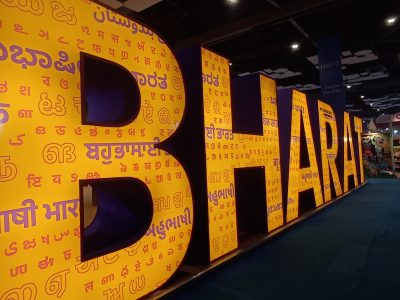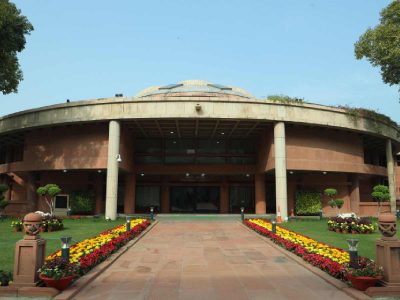Organised across a sprawling space of over 50,000 square metres, the World Book Fair at Pragati Maidan in Delhi is host to a massive congregation of publishers. The fair has run for a better part of the second week of the month, and will shut its doors on February 18.
The wide, all-encompassing landscape, suffice to say is a book-lover’s paradise with a certain smell of both the old and the new intermingling together, spreading a certain kind of warmth in the air. Not one corner is left unused and at least one book stall awaits you with open arms for embrace if you only choose to look.
A shoal of people spread across the ocean of books were not limited to the usual suspects of bunking college folks, journalists and freelancers, but also included school teachers, engineers and lawyers, who usually would have been spending their weekdays in blues. It was clear that the terrible state of Delhi-NCR traffic could barely pose a threat for the many who visited the book fair.

On the contrary, it was the traffic which turned out to be a massive boon for a few who got the option to work from home. However, the call for WFH eventually turned into an excuse to visit the book fair.
Siddharth Chapalgaonkar, a Supreme Court lawyer residing in Delhi and hailing from Maharashtra, was one such person who found himself saved because of the border restrictions imposed by the police to ward off the protesting farmers.
Illustrating his luck, he elaborated that owing to the issue he had finally gotten the chance to visit the fair. “I was already planning to visit the book fair today. If it would not have been today then I would not have had the chance to visit it any day,” he said.
Armed with a cloth bag with a book placed firmly within it, the 32-year-old lawyer elaborated upon his experience.
“It’s a joy to be present here, especially if you are a lover of Hindi books. I have become a fan of ‘Nayi Kitaab Prakashan’. They are much more youth-centric and have all of the newer authors. There’s not much that has changed since last year but I would say that today the crowd is a tad less but that is mostly because of the traffic, I believe,” Chapalgaonkar said.

However, an aficionado of fiction, hailing from Bihar, thought otherwise. The book fair failed to impress her.
Shreya, a 26-year-old freelance researcher residing in Delhi, aired her frustration out condemning the book fair for becoming much less ‘inclusive’ now.
“I had also come last year and it was not this exclusive then. There is no way that a new reader can come here and be at ease if they are looking to get into the habit of reading. This fair, literally, only works in your favour if you know what you are looking for, and also, if you really know your books,” she said.
Yet, an Italian visitor to the book fair, Franco La Cecla, an illustrator and renowned anthropologist by profession, stated in contradiction, embracing the “international” event with all his heart.
“It is my first time at the Delhi book fair and so far, I am loving it. There is an immense international spirit in the air here, and it is just very diverse which is a joy to see,” he said.
La Cecla was accompanying the Bologna contingent from Italy.

Sukrit, on the other hand, was in awe of the book fair.
Hailing from Pune, the 30-year-old government school teacher had found himself in Delhi on the lookout for books suited for his curriculum.
“I am not looking for books for myself. I already have a lot at home and I need to finish up with them. I am actually here for my students. I plan on buying books based on our curriculum for the children,” he said.
He further disclosed, “The Delhi book fair isn’t as elaborate or visitor friendly as other book fairs and that is a problem, for sure, but if you know your books, then it is a pretty good place to be in.”
On the other hand, Anita Gajria, a fashion designer by profession, set the way forward as she took to browsing through the many enclosures, and found the foreign pavilions, which were a highlight of the book fair.
“Last time around, there was nothing of this sort, at least not this grand, but this year the foreign pavilions, especially the Saudi Arabian enclosure is great. There’s so much to see and know, especially about their culture and heritage,” she said.
The heartfelt response of the visitors was supported by the sales figures disclosed by Sameer Mahale, the Vice-President of Sales of Penguin Random House.
He told Patriot, “We have recorded an amazing increase in sales this year, increasing it by 30 per cent. I have noticed that on average, a single person is purchasing around four or five books. However, I also believe that our sales have increased because of the increase in the number of books — from 25,000 in 2023 to 35,000 in 2024.”
However, everything was not all joyous as Umesh, the supervisor of Partap Publisher, elaborated that there had been more or less no sale on Tuesday, and the most they had seen was over the weekend.
Similar circumstances had also hit Macmillan Publishers. They decided to not face the brunt of lacklustre sales, and have presently, turned it into a Business-to-Business model through the weekdays except Friday. Their Business-to-Customer model is slated to resume from Friday through to the weekend.
“We are still trying to recover the numbers we stacked right before COVID,” Umesh said.
Amit Singh, the head Public Relations Officer of the National Book Trust, India, on the other hand emphasised on the massive increase in footfall that the book fair was now witnessing.
He said, “Footfall is much more than last year when we received 12 lakh people in total. This time around, we have already seen over eight lakh people on the first three days (3.5 lakh people on February 10, 2.5 lakh on February 11 and around 2.5 lakh on February 12).”
An overall verdict concerning the event has been rather positive. However, a seeming tension has remained with the visitors — the unavailability of books in regional languages.
Gajria said, “Last year, there were a lot more regional bookstores, as far as I remember, but there’s a difference in the number of regional bookstores now.”
Shreya proceeded to call the invisibility of certain languages a matter of concern.
“If I only know my mother tongue, and when I am from Bihar, why should they expect me to know Hindi or English by default? I did not see any regional language stand this time at all,” she said.
Similarly, Chapalgaonkar expressed his dismay at not seeing any Marathi enclosure or bookstore.
“It’s not like I hate Hindi. I love Hindi books too, as you can see, but I expected some form of Marathi literature being displayed here. I am just disappointed at its absence,” he said.
Proudly showcased on the book fair’s hoardings and banners are the words of its theme pavilion, ‘Bahubhashi Bharat’ or ‘Multilingual India’. Among its private regional language enclosures was one Bangla stall, one Malayalam stall, around six Urdu stalls, and a few Punjabi stalls.
Speaking about the lack of private stalls for regional languages, the PR Head of the National Book Trust said, “The private stalls are given space on the basis of how proportional it is to the number of people coming to the fair who would be probably visiting the said stalls. There’s no point for me to give a stall to a private publisher who would only be losing money because of lack of visitors.”





